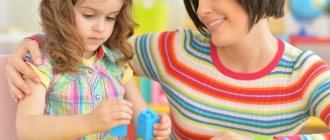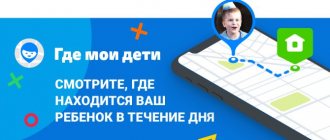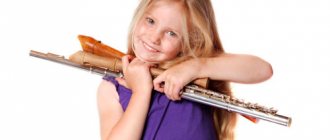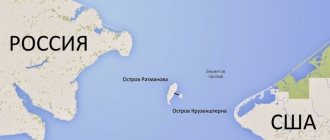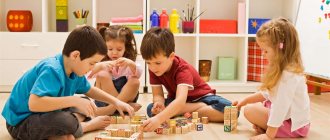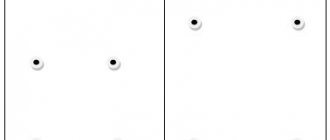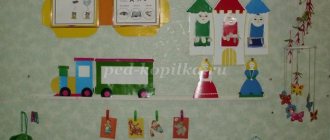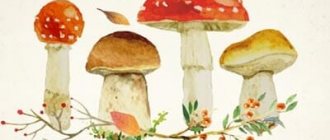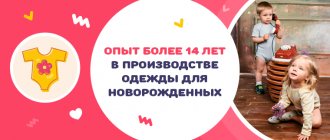Stories for the little ones: how to choose books with stories for the little ones, what to look for when reading, how to teach them to understand books without pictures. Texts of stories for reading to children 1-2 years old.
The selection of children's books in stores is now huge! And books - toys, and books - cut-outs in the shape of various animals, cars, nesting dolls, toys, textile books for the development of fine motor skills, books - lacing, floating waterproof books for swimming, talking books, music books, huge thick collections of poems and fairy tales for the little ones. And it’s wonderful that from the very first years of life a child has the opportunity to get acquainted with beautiful and interesting children’s books in all their diversity.
But today we’ll talk about other books - traditional story books for kids . They are less popular than books with fairy tales or poems, but young children really need them! It is in stories that a child becomes more familiar with the world around him, with the lives of people.
How to choose story books for little ones?
First. For reading to the little ones, thin books with pictures are more suitable than thick collections of fairy tales or short stories. One book is one story in pictures, or several short stories.
Second. Pictures in a book for children 1-2 years old should be realistic. That is, the illustrations in the book should not contain blue cows or hares with short ears and long tails. From the picture, the baby should get an accurate idea of the world around him; children of this age do not yet understand humor! Illustrations are needed to clarify ideas about the world, and not to confuse the child. Naturally, realism does not exclude decorative details - let us remember, for example, illustrations for fairy tales by the famous artist Yu. Vasnetsov.
The perspective in which the hero of the story is depicted is very important - all the heroes of the story should be easily recognizable by the child in the pictures.
Third. At the early stage of understanding literature, a drawing represents for a child the very life around him, which cannot be replaced by a word. Therefore, it is necessary that the child can use the pictures to follow step by step what they are telling him about (remember the story “Chicken” by K.I. Chukovsky).
For the youngest children, a picture book is alive! They feed the drawn horse, pet the cat, talk to the pictures, and can even wait for “the bird to fly away” from the picture.
Fourth. It is very important that the baby’s first books are beautiful. It is at an early age that children develop an understanding of beauty. They like beautiful clothes, a beautifully decorated room, beautiful flowers or beautiful pictures. And they clearly prefer beautiful objects and books.
Progress of the lesson
The teacher reads the story Ya . Thai (you can change the names of the children and use the names of the group members)
: “There is snow everywhere. Masha has a sled. Misha has a sled. Tolya has a sled. Galya has a sled. One dad without a sled.
He took Galina's sled, hitched it to the Tolins, Tolina - to the Mishins, Mishins - to the Mashins. It turned out to be a train .
And dad pulls the string and says:
So he is a locomotive.
Guys, let's look at the illustration for the story , who do you see in it?
3. Conversation on the content of the story .
- name the names of the children who sled.
-How did dad make a train out of a sleigh ?
-Who was the driver? what was he shouting?
-Who was the conductor? What did she shout?
-Who was dad? What was he shouting?
-What did dad come up with so that all the children could play together (dad came up with a game)
– why were the children having fun? (They all played together, amicably.
That's right, and the children immediately began to have fun, no one was sad alone. So today we won’t be sad, because it’s bad to be alone. I offer you the game “Looking for a Friend”
(while the music is playing, children move freely around the hall and choose a friend; after the music ends, they stand in pairs, holding hands) the game is repeated 3-4 times.
We had a lot of fun because we all played together, like in a story about a train .
Next, the children line up one after another demonstrating the tu-tu train with the words
Over the mountains and through the valleys.
The long train is coming
Across the river on a bridge.
Buzzed tu tu tu.
And they return to their places.
Summary of GCD for introducing children to fiction. Fairy tale “The Frog Princess” Summary of educational activities for introducing children to fiction. Fairy tale "The Frog Princess". Objectives: To introduce children to Russian folk tales.
Summary of the educational activity with children of the senior group on familiarization with fiction “Acquaintance with the story by N. Nosov “On the Hill” Goal: to introduce children to the story “On the Hill” by N. Nosov. Objectives: 1. motivate children to perceive and understand the text; 2. learn to give characteristics.
Summary of educational activities to get acquainted with modern professions “Designer” Program content: to form children’s understanding of the types of professions and their significance for humans, to consolidate knowledge about different areas.
Summary of a lesson on appliqué in the senior group “Train” Program objectives: To consolidate the ability to work with paper and glue, to create a holistic composition from elements. Develop curiosity.
Summary of a modeling lesson in the middle group: “Here is our train rolling along, the wheels are knocking” Summary of a modeling lesson in the middle group: “Here is our train rolling along, the wheels are knocking. “. Goal: to teach children to compose a collective composition from.
Summary of mathematics lessons in the first junior group. Game "Train" Math lesson notes in 1 ml. group. Topic: Game "Train" Programming tasks. Develop combinatorial abilities to engage children.
Summary of a lesson in the senior group on getting acquainted with the elements of Khokhloma painting “Rowanka” “Rowanka” Program content: 1. Continue teaching children to draw a wavy line with a smooth movement, simple leaves using a stroke.
Country of stones. GCD summary for introducing children to stones and their properties Goal: to introduce children to stones and their properties, and where they are used. Objectives: expand children’s understanding of the properties of stones.
Source
How to read stories to little ones: 4 simple rules
First. Stories can and should not only be read from a book, but also told! And this is very important! What is the benefit of storytelling? The fact is that in the case of storytelling, your word is a “living word”!
When you tell a child a simple story, a fairy tale or a short story, you look into his eyes, you can pause if necessary, slow down the pace of speech, introduce a new intonation. You see the baby’s reaction to the story and can take it into account. In addition, the child sees your face, emotions, and the process of your speech.
Therefore, it is better to first get acquainted with the story , and then read it to the baby. If you are “attached” to the text and bury yourself in it while reading, then the baby will quickly become distracted and lose interest.
Reading a story is our dialogue with a child about the book, but not a monologue of an adult buried in the text.
It’s wonderful when you know your favorite stories by heart and tell them simply from the heart at the right moment - without a book.
I have a system of cards with short stories and poems - they are always with me. And at the right time you can always use them if you need to remember something.
Second. If you bring home a new book, you don’t need to start reading it right away. First, give the book to your baby - let him get to know it, examine it, leaf through the pages, look at the pictures and play with them - feed the horse, share his impressions with you (this can be just exclamations, pointing gestures, intonations, if the baby does not speak yet ).
After the first acquaintance with the book, look at the pictures with your child, tell the child what is drawn on them. In this case, it is better to quote words from the text of the story, which the child will later hear when reading it. For example: “Masha has a sled. Misha has a sled. Tolya has a sled. Galya has a sled. One dad without a sled” (based on the story by Ya. Taits). Pay attention to interesting or unusual details in the illustrations (the clothes of the characters, objects in their hands, what is around them), examine them and name them.
After the first acquaintance with the book, you can read the story to your baby. If you start reading a new book right away, then the children will not listen - they reach for the book, want to pick it up, want to turn the pages, stroke the cover, and begin to get distracted.
Third. At the age of 1 year 6 months to 2 years, it is very important to teach the child to perceive a story without visual support (i.e., without a picture or dramatization of the content of the story). Otherwise, the baby may develop a not very useful habit. This is the habit of waiting for toys to be shown and saying words only under this condition. If you do not teach your child to listen to speech before the age of 2, then in the future the child will have difficulty engaging in dialogue, constantly demands pictures, does not answer questions, does not perceive audio recordings or reading books without pictures, and has difficulty perceiving speech by ear without visual support. You will find examples of stories to read to children without visual support below.
What stories can children understand without pictures?
- Up to 2 years old , children understand adults’ stories about events that are happening at a given moment in time or are very familiar to them.
- After 2 years, children begin to understand, without showing pictures, the stories of adults about events that are familiar to them from past experience.
- And from the age of 2 years 6 months, children begin to understand, without showing pictures, adults’ stories about events that did not happen in their lives, but they are familiar with similar phenomena or with individual elements of the story’s plot. Also, from 2 years 6 months, a child can convey the content of a familiar fairy tale or story based on questions (that is, he can answer an adult’s questions about the content of the story).
Fourth. What to do first - watch a cartoon based on the story or read the text of the story? First, we introduce the child to the book - look at the illustrations, read the story. This is the base. And later you can watch a cartoon based on a familiar story book. In a cartoon, most often the child does not perceive the text, because... captivated by flashing pictures.
Lesson notes on retelling the story “Train” by Y. Taits
Nina Frolova
Summary of a lesson on retelling the story by Y. Taits “Train” Purpose: to teach children
to retell a short story together with the teacher, to develop the ability to understand the content of the story .
1. consolidate the ability to independently retell a story ;
2. cultivate the ability to listen to each other;
3. consolidate the names of modes of transport and their classification.
Material: illustration for the story , pictures with the image
types of transport, paintings depicting the sea, road and sky.
1. Talk about the difference between a story and a fairy tale .
- What do you think a story ? (Child's response)
.
The story
is written by the writer. A story must have an author. Fairy tales
people come up with. The story talks about real events, about what can actually happen in life. And fairy tales tell about fictitious events. There is a lot of fantasy and fiction in the fairy tale.
2. Reading, looking at illustrations for the story .
Reading the story I. Thai " Train "
:
There's snow everywhere. Masha has a sled. Misha has a sled. Tolya has a sled. Galya has a sled. One dad without a sled. He took Galina’s sled, hitched it to the Tolins, Tolina to the Mishins, and Mishins to the Mashins. It turned out to be a train .
— Guys, do you think what I read is a story or a fairy tale ? (Listen to the answers)
.
3. Conversation based on content.
- Guys, what is this story ? (Children's answers)
. (It’s true that everyone had a sled and only one dad didn’t have a sled).
- How does the story ? (That there is snow everywhere and all the guys have sleds)
.
- What time is the story ? (About winter)
.
- Why do you think it was in winter? (That’s right, well done, because there was snow everywhere and the guys had sleds, and we only go sledding in winter).
— What are the names of the children who ride sleds? (Tolya, Galya, Misha, Masha)
.
- Who doesn’t have a sled? (At dad's)
.
— How did the guys get the train ? (Dad took the sled and hooked them to each other)
.
4. Re-reading the story .
5. Retelling the story.
-Now we will retell the story called “ Train ”
. I will start, and you will finish it.
Hello Zimushka-winter! (bow)
.
What did you bring as a gift? (we spread our arms to the sides)
.
White fluffy snow (we squat and run our hands over imaginary snow)
.
Silvery frost (stand up, raise our hands up)
.
Skis, sleds and skates (we imitate the movements of skiers and skaters)
.
And there are lights on the tree! (raise your hands up, turn the “flashlights”
).
7. Didactic game “Rides, swims, flies”
.
Goal: fixing the names of modes of transport and their classification.
Children who have pictures of land transport stand up and show how it drives (they depict a steering wheel and say “beep-beep”
).
The guys with pictures of air transport show how it flies, and the rest, who have a water mode of transport, depict how they row with oars and say “wow-wow-wow”
.
- And now you need to take your picture with the image of a vehicle to where the place corresponding to this particular type of transport is depicted (road, sea or sky with clouds)
. Children take turns attaching the transport to the right place.
- What is the name of the story that I read to you today?
- That's right, " Train "
.
- Why is it called that?
— Because dad made a train .
- Did you like it? (Children's answers)
.
Summary of the integrated lesson “Fun Train” in the first junior group on familiarization with the outside world and speech development Tasks. 1. Development of attention and visual-effective thinking. 2. Enrich children’s knowledge about wild animals, their habits, appearance, and form.
Summary of educational activities on speech development in the middle group “Retelling the story by Y. Taits “Train” Topic: “Retelling the story by Y. Taits “Train” Type: Integrated lesson Program content or objectives Educational objectives • Teach children.
Summary of an open lesson on speech development in the middle group. Retelling of the story by Y. Taits “Train” Summary of an open lesson on speech development in the middle group. Retelling of the story by Y. Taits “Train” Prepared by: teacher Savinykh E. Yu. Purpose:.
Lesson summary application in the middle group “Train” yimdastyrylan ou is-reketinі tehnologiya kartas Technological map.
Summary of a lesson on teaching retelling of the fairy tale "Teremok" with subsequent dramatization for children 4-5 years old with speech disorders. Summary of a lesson on teaching retelling with subsequent dramatization for children 4-5 years old with severe speech impairments. Topic: Storytelling.
Lesson summary for the junior group “Fun Train” Program content: Development of attention and visual-effective thinking. Consolidating the names of animals and their characteristics in children's speech.
Summary of a lesson in the first junior group using ICT “Funny Train” Municipal educational institution of additional professional education “Methodological center for advanced training of teachers.
Lesson notes “Magic Train” with preparatory group children with mental retardation MUNICIPAL BUDGETARY PRESCHOOL EDUCATIONAL INSTITUTION KINDERGARTEN No. 185 CITY DISTRICT UFA CITY RB LESSON SUMMARY “Magic.
Summary of the lesson “Fun Train” Program content: 1. Development of attention and visually effective thinking. 2. Consolidating the names of animals in children’s speech. 3. Expansion.
Source
Stories for little ones K.D. Ushinsky
Mice. K.D. Ushinsky
Mice, old and small, gathered at their hole. They have black eyes, small paws, teeth, gray fur coats, ears sticking out at the top, tails drag along the ground.
Vaska. K.D. Ushinsky
Cat-cat - gray pubis. Vasya is affectionate and cunning: velvet paws, sharp claws. Vasyutka has sensitive ears, a long mustache, and a silk fur coat. The cat caresses, bends over, wags its tail, closes its eyes, and sings a song.
Cockerel with his family. K.D. Ushinsky
A cockerel walks around the yard: he has a red comb on his head and a red beard under his nose. Petya's nose is a chisel, Petya's tail is a wheel; there are patterns on the tail, spurs on the legs. Petya rakes the pile with his paws and calls the hens and chicks together: “Troublesome housewives! Get your chickens together, I brought you some grains!”
Goat. K.D. Ushinsky
A shaggy goat walks, a bearded goat walks, waving its faces, shaking its beard, tapping its hooves: it walks bleating, calling for goats and kids.
Sow. K.D. Ushinsky
The sow's snout is not elegant: its nose rests on the ground; mouth to ears, and ears dangling like rags; Each leg has four hooves, and when it walks, it stumbles. The sow's tail is like a screw, its ridge is humped, and stubble sticks out on the ridge. She eats for three, gets fat for five.
Geese. K.D. Ushinsky
The hostess came out and beckoned the geese home: “Pull-pull! White geese, gray geese, go home!”
And the geese stretched out their long necks, spread their red paws, flapped their wings, opened their noses: “Giga! We don't want to go home! We feel good here too!”
Cow. K.D. Ushinsky
The cow is ugly, but she gives milk. Her forehead is wide, her ears are to the sides, there are not enough teeth in her mouth, but her face is large. She tears grass, chews gum, drinks swill, moos and roars, calling for her mistress.
Eagle. K.D. Ushinsky
The blue-winged eagle is the king of all birds. He builds nests on rocks and on old oak trees; flies high, sees far. The eagle has a sickle nose, hooked claws, long wings; An eagle flies in the clouds, looking for prey from above.
Woodpecker. K.D. Ushinsky
Knock-Knock! In a deep forest, on a pine tree, a black woodpecker is carpentering. It clings with its paws, rests its tail, taps its nose, scares away ants and boogers from behind the bark.
Lisa Patrikeevna. K.D. Ushinsky
The godmother fox has sharp teeth, a thin snout, ears on the top of her head, a tail that flies away, and a warm fur coat. The godfather is well dressed: the fur is fluffy, golden, there is a vest on the chest, and a white tie on the neck. The fox walks quietly, bends down to the ground, as if bowing. He wears his fluffy tail carefully; digs deep holes with many entrances and exits; loves chickens, ducklings, not rabbits.
The next two stories are stories from the 20th century. They are written in a very accessible language and are understandable to children even without pictures.
Abstract of the GCD “Retelling the story of Y. Taits “Train”
Abdulova Dzhume Sirazhutdinovna
Abstract of the GCD “Retelling the story of Y. Taits “Train”
Goal: to teach children to retell a short story together with the teacher, to develop the ability to understand the content of the story
Tasks:
educational: to consolidate the ability to independently retell a story
developing: consolidate the names of modes of transport and their classification
educational: cultivate the ability to listen to each other
Equipment and materials: laptop, projector, smart board, document camera
Material: illustration for the story, pictures with the image
types of transport, paintings depicting the sea, road and sky.
Contents of educational
I. Introduction to the game situation
Talk about the difference between a story and a fairy tale.
– What do you think a story is? (Child's answer). Story
the writer composes. A story must have an author. Fairy tales
people come up with. The story talks about real events, about what can actually happen in life. And fairy tales tell about fictitious events. There is a lot of fantasy and fiction in the fairy tale.
Stories for little ones Ya. Taits
Story by Ya. Taits “Geese”
My grandmother had geese on the collective farm. They hissed. They pinched. They were talking to each other: “Ha-ha!” "Ha-ha!" “Yeah!” "Ha-ha!" “Yeah!” Nadya was afraid of them. She shouted: “Grandma, geese!” Grandma said: “You take a stick.” Nadya took a stick, and how could she swing at the geese? - Get out of here! The geese turned and walked away. Nadya asked: “Are you scared?” And the geese answered: “Aha!”
Story by Ya. Taits “Train”
There's snow everywhere. Masha has a sled. Misha has a sled. Tolya has a sled. Galya has a sled. One dad without a sled. He took Galina's sled, hitched it to the Tolins, Tolina - to the Mishins, Mishins - to the Mashins. It turned out to be a train. Misha shouts: - Tu-tu! He is a machinist. Masha shouts: “Your tickets!” She's a conductor. And dad pulls the string and says: “Choo-chuh... Chuh-chuh... So he’s a locomotive.”
At the age of 1 year 6 months to 2 years, it is very important to start teaching a child to listen to stories without visual support - that is, without showing pictures based on the content of the story, without dramatizing or showing toys. I have made a selection of such stories for children, which they understand from the content itself. In the collection, the stories are grouped by age: from 1 year 9 months to 2 years, from 2 years to 2 years 6 months, from 2 years 6 months to 2 years 11 months.
Lesson notes "Train"
Summary of a lesson on speech development in the middle group.
Retelling of the story “Train” by Y. Taits.
Target:
teach children to retell a short story.
Tasks:
Learn to retell the story yourself; highlight the “S” sound in words.
Develop the ability to expressively convey the direct speech of characters.
Develop the ability to listen to each other.
Equipment and materials:
Painting “Sasha and the Snowman”, toy sleigh, image of objects starting with the sound “S”.
Progress of the lesson.
Examination of the painting “Sasha and the Snowman.”
Vs:
Guys, look carefully at the picture, what is drawn on it?
Children:
The picture shows a boy with a sled and a snowman.
Vs:
That's right, the picture shows a boy with a snowman and a sled.
Vs:
What time of year is shown in the picture?
Children:
Winter.
Vs:
That's right, winter.
Vs:
What games can you play in winter?
Children:
snowball fights, sledding.
Vs:
That's right, you can play snowballs, build barricades out of snow, go sledding.
Vs:
Guys, I want to invite you to play an interesting game with me, would you like it?
Children:
Yes.
Offer children a round dance outdoor game:
“Our children got into the sled”
Vl: Our children got into the sled, flew along the path, rolled far, no one will catch up with them! Suddenly the sled turns sideways - bang, everyone ends up in a snowdrift! Well, get up, get up, my friend, and shake off the snow (the children “fall”, then get up, “shake off the snow” from themselves and from their neighbor). Get back into the sled and have fun rolling down the hill!
Vs: Well done
guys, you played well. Look what an interesting book I have. It is called “Train” and the story was written by Ya. Taits. Want to listen?
Children:
Yes.
V-l:
then sit down on the chairs.
Reading the story by Ya. Taits. "Train".
There's snow everywhere. Masha has a sled. Misha has a sled. Tolya has a sled. Galya has a sled. One dad without a sled. He took Galina’s sled, hitched it to the Tolins, Tolina to the Mishins, and Mishins to the Mashins. It turned out to be a train. Misha shouts: tu-tu! - He is a driver. Masha shouts: “Your tickets!” She's a conductor. And dad pulls the string and says: chuh - chuh, chuh - chuh. So he is a locomotive.
Conversation - survey.
Vs:
Did you guys like the story?
Children:
Yes.
Vs:
What time of year is the story talking about?
Children: oh
winter.
Vs:
why do you think it was winter?
Children:
because there was snow everywhere, and the children were sledding.
Vs:
That's right, well done, because there was snow everywhere and the guys had sleds, and we only go sledding in winter.
Vs:
how does the story begin?
Children:
that there is snow everywhere and all the guys have sleds.
IN-
l: That's right guys, well done.
Stories for children 1-2 years old without showing
We teach kids to listen and understand speech without visual support (that is, without a picture, scene, or display of objects)
Stories without showing for children from 1 year 9 months to 2 years
Sveta and the dog (Author – K.L. Pechora)
Sveta went for a walk, put on a hat and coat and walked with her feet - stomping. And there the dog barks: “Aw-aw!” Don't be afraid, Sveta, the dog doesn't bite!
Who went for a walk? Who did she meet?
Feeding the cat. Author – K.L. Pechora
The cat came home and meowed: “Meow-meow.” He wants to eat. Mom poured milk for the cat and said: “Here, kitty, drink milk!” And the cat drank the milk.
- Who did I tell you about?
- What was the cat doing?
- What did mom give her?
Stories for children from 2 years to 2 years 6 months without showing
Tanya will sleep. Author – K.L. Pechora
The girl Tanya is tired. I played all day. Mom said: Let's go babes. I'll put you on the bed. I’ll sing a song.” Tanya doesn't want to sleep Ay-ay-ay! All the kids are already asleep. Tanya lay down on the bed. She closed her eyes, and her mother sang a song to her: “Bayu-bayu-bayu. I’m rocking Tanya.” Quiet, guys. Tanya is sleeping.
You can repeat the story twice. Questions for your child to check their understanding of speech: - Who did I tell you about? - What did mom sing to Tanya? - Tanya doesn’t want to sleep? Ah ah ah. -Where did mom put Tanya? - Did Tanya fall asleep?
Ball. The author of the story is L.S. Slavina
Once upon a time there lived a boy, Petya. He had a dog, Sharik. Once Petya called Sharik: “Sharik, Sharik, come here, I brought you meat.” But Sharik is not there. Petya began to look for him. Sharik is nowhere to be found: neither in the garden nor in the room. But Sharik hid under the bed, and no one saw him there.
Doll bed. The author of the story is L.S. Slavina
Once upon a time there was a girl Galya, she had a doll Katya. Galya played with the doll and put her to bed in her crib. Suddenly the crib broke. There is nowhere for the Katya doll to sleep. The girl Galya took a hammer and nails and repaired the crib herself. The doll now has a crib.
Tanya and brother. The author of the story is L.S. Slavina
Once upon a time there lived a girl, Tanya. She had a little brother, a little boy. Mom gave the kids something to eat and left. Tanya ate and began to play, but her little brother could not eat on his own, he began to cry. Then Tanya took a spoon and fed her brother, and then they began to play together.
Ship. The author of the story is L.S. Slavina
Once upon a time there lived a girl, Natasha. Dad bought her a boat from the store. Natasha took a large basin, poured water and let the boat float, and put a bunny in the boat. Suddenly the boat capsized and the bunny fell into the water. Natasha pulled the bunny out of the water, dried him and put him to bed.
Assistants. The author of the story is N. Kalinina
Sasha and Alyosha helped set the table. Everyone sat down to dinner. The soup was poured, but there was nothing to eat. That's it, helpers! The table was set, but no spoons were placed.
Cube upon cube. The author of the story is Ya. Taits
Masha puts cube on cube, cube on cube, cube on cube. She built a high tower. Misha came running: - Give me the tower! - I'm not giving it! - Give me at least a cube! - Take one cube! Misha reached out his hand and grabbed the lowest cube. And instantly - bang-bang-bang! — the whole Machine Tower has collapsed!
River. The author of the story is Ya. Taits
Our Masha doesn’t like porridge, she shouts: “I don’t want it!” Don't want!" Mom took a spoon and ran it over the porridge, creating a path. Mom took the milkman, poured milk, and it turned out to be a river. - Come on, Masha, drink from the river and eat by the shore. I drank the whole river, ate all the banks, only one plate remained.
Stories without showing for children from 2 years 6 months to 2 years 11 months.
About the girl Katya and the little kitten.
Stories by Ya. Thai
By berry
So the strawberries are ripe. Grandmother and Nadya took the mugs, went into the forest, let's collect them. Only grandma in the mug, and Nadya in her mouth. We came home. Grandma has a full mug, but Nadya has nothing, even grandpa has nothing to treat her with. Nadya felt ashamed. The next day she went into the forest, didn’t eat a single berry - it was all in a mug. She came home, put the mug in front of her grandfather and said: “Eat!” - What about yourself? - I ate yesterday. “Yesterday doesn’t count,” said grandfather. - Let `s together. And so she and Nadya began to eat from the same mug. Nadya - a berry, and grandfather - a berry. Nadya - a berry, and grandfather - a berry. So they ate it all.
Masha was taken to the zoo. Here's a wolf. Masha recognized him immediately: “Why did you eat Little Red Riding Hood?” The wolf is silent. - Why did you offend the three little pigs? The wolf tucked his tail. - Now sit in the cage, you bad gray wolf! The wolf turned away. So he is ashamed. So there won't be any more
Pencil
Dad brought a big pencil. Masha shouts: “For me!” Misha shouts: “For me!” Dad said: - Quiet! We'll share it. I ran one end - blue. I swiped the other end - red. Misha and Masha laugh: “Let’s share a pencil!” Misha has a blue end, and Masha has a red end. Misha draws blue pictures, Masha draws red ones.
There was grass
The grass grew and grew and grew like this, up to Nadya’s waist. Grandfather took the scythe and began to mow: zhik-zhik, zhik-zhik... Nadya asked: “Can I mow?” “You can’t,” said grandfather, “you’ll cut yourself.” You're a better thief! Grandfather gave Nadya a rake and showed her how to rake. And when the hay dried up, he swept away the stack. And Nadya helped him and said: “When there was grass, it became hay!” There was grass - there was hay.
All here
Nadya and her grandmother went to another field. The ears of corn are visible and invisible on it. And everyone is a little mustachioed. Nadya asked: “Grandma, what’s growing here?” - Bread, granddaughter! - Bread? Where are the buns? - And the rolls are here, granddaughter. - And the bagels? - And the bagels are here. - And gingerbread? - And the gingerbread is here. It's all here, granddaughter. Nadya looks at the mustachioed ears of corn. He wants to guess: where is the bread, where are the rolls, and where are the gingerbreads.
Obedient rain
Nadya asked: “Grandfather, who are you on the collective farm?” - I am the boss of the rain. Nadya laughed: “And the rain doesn’t have bosses!” - And that’s what happens! - said grandfather. He took Nadya to the river. There are long, long garden beds. And above them there are long, long thin pipes with holes in the pipes. Grandfather opened the tap - and immediately rain sprayed from all the pipes and let's water the beds! Then grandpa turned off the tap and the rain stopped. Nadya asked: “Can I?” She opened the tap and it began to rain. I closed it and it stopped. That's how obedient the rain is for grandpa on the collective farm!
White-white
Nadya asked: “Grandma, who are you on the collective farm?” - I am a birder. -Where are your birds? - I will show you now. Grandma took Nadya to the farm. There are many low houses in the meadow. Many, many white chickens came out of them, and everything around became white and white. It was as if snow had fallen and Winter had come. Grandmother poured out cereals. The chickens began to peck, began to knock their noses: “Knock-knock... Knock-knock...” As if the rain was knocking and autumn had come. Then the chickens went to their houses. And everything around became green again. It's like summer has returned. SHOO... Grandma also had chickens at home. Nadya asked: “Can I feed them?” - Can! Nadya took a bowl of millet and began calling: “Chickens, chickens, here!” But the chickens don't come. - Grandma, they are not coming! - And you tell them: chick-chick! Nadya said: - Chick-chick-chick. Then chickens came running from all sides. Let's peck the millet. They devoured everything in an instant. - All! No more! - said Nadya. And she showed the chickens an empty bowl. But the chickens don't leave. They are standing, waiting. - Grandma, they are not leaving! - And you tell them: shoo-shoo! Nadya said: “Shoo-shoo-shoo.” The chickens understood everything and dispersed.
Masha was in the village. With grandparents. There were angry geese there. They walked in single file and talked: “Ga-ha?” - Yeah! - Ha-ha? - Yeah! They wanted to pinch Masha. Masha shouted: “Grandma, geese!” Grandmother said: “Don’t be afraid, take a stick.” Masha took the stick and waved it: “Come on, geese, go away!” The geese went away. Masha said: “Are you scared?” And the geese answered in one voice: “Aha!”
Waist-high
Masha and her grandmother went out into the field. There are low green bushes there. The rows are even. Like a thread. - What is this, grandma? - Corn, granddaughter. Masha stood next to her and tried it on: “Oh, what a little corn.” I'm up to my waist! And a month later they came to that field again. The bushes were now tall, tall! Masha stood next to her, put her hand on her head, and tried to figure it out: “Look, grandma!” They used to be up to my waist, now I'm up to my waist. What a cornball!
River
Our Masha doesn’t like porridge, she shouts: “I don’t want it!” Don't want!" Mom took a spoon and ran it over the porridge, creating a path. Mom took the milkman, poured milk, and it turned out to be a river. - Come on, Masha, drink from the river and eat by the shore. Masha drank the entire river, ate all the banks, only one plate remained.
Cube by cube
Train
There's snow everywhere. Masha has a sled. Misha has a sled. Tolya has a sled. Galya has a sled. One dad without a sled. He took Galina’s sled and hitched it to Tolin’s. The Tolins go to the Mishins, the Mishins to the Mashins. It turned out to be a train.
Misha shouts: “Too-too!” He is a machinist.
Masha shouts: “Your tickets!” She's a conductor.
And dad pulls the rope and says: “Choo-choo....Choo-choo”…. So he is a locomotive.
Short stories for children are useful because they teach kids to concentrate for a while from beginning to end. The more often you practice reading them, the longer the period of concentrated attention will be. The site Non-standard children wishes you successful reading training.
Source
Summary of educational activities in the first junior group on speech development “Acquaintance with the story by Y. Taits “Train”
Timchenko Evgenia
Summary of educational activities in the first junior group on speech development “Acquaintance with the story by Y. Taits “Train”
Summary of educational activities in the 1st junior group on speech development “ Introduction to the story I. Thai " Train "
.
Author: Timchenko E. V.
Goal: Improve the ability to listen to a story without visual accompaniment.
Educational: To develop children’s ability to listen carefully to a story , to understand the teacher’s questions that are simple in form and content and to answer them. Continue to form children's understanding of the winter season and winter fun.
Developmental : Develop attention , thinking, memory. Develop the ability to understand the text and perform movements corresponding to the model. Develop motor activity and coordination of movements. Develop sensory perception (primary colors)
.
Educating: Cultivate a friendly attitude between peers.
Preliminary work: P/I “Our children got into the sleigh”
.
Equipment and materials: Letter from a snowman, pictures of sleds, Children sledding (2-3 pcs.)
.
